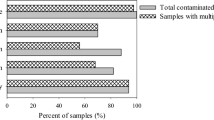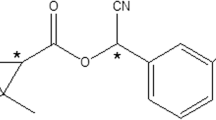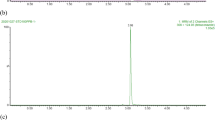Abstract
The enantioselective behaviors of chiral pesticides would affect the accuracy of risk assessment. This study evaluated the enantioselectivity of chiral triticonazole (a widely used fungicide) in three kinds of fruits. Firstly, the enantioseparation of triticonazole enantiomers was carried out within 1.2 min utilizing CHIRALPAK OJ-3 column with a mixture of CO2 and methanol (93:7, v/v) using SFC-MS/MS. Secondly, field trials were conducted to clarify the enantioselective degradation and residue of S-( +)-triticonazole and R-(–)-triticonazole in fruits. The initial concentrations of rac-triticonazole were 25.1–93.1 ng/g, and enantioselective degradation was observed in pear, peach, and jujube after 2 h, 10 days, and 3 days, respectively. The degradation of S-( +)-triticonazole was fastest in pear (T1/2, 2.01 days), while the T1/2 of R-(–)-triticonazole was 5.02 days. The residue concentrations of rac-triticonazole were less than the MRL set by EU (10 ng/g) on the 3rd and 21st day in pear and peach, respectively, which were lower than 10 ng/g in jujube on the 30th day (no MRL). Finally, we found that the dietary intake risks of rac-triticonazole in fruits were low for 2–7 age, 20–50 age/female, and 20–50 age/male. The current study could provide complimentary references for the rational usage, MRL formulation, and risk assessment of chiral triticonazole.


Similar content being viewed by others
Data availability
Not applicable.
References
Basheer AA (2018) Chemical chiral pollution: impact on the society and science and need of the regulations in the 21(st) century. Chirality 30:402–406. https://doi.org/10.1002/chir.22808
Bielska L, Hale SE, Skulcova L (2021) A review on the stereospecific fate and effects of chiral conazole fungicides. Sci Total Environ 750:141600. https://doi.org/10.1016/j.scitotenv.2020.141600
Campbell GF, Crous PW, Lucas JA (1999) Pyrenophora teres f. maculata, the cause of Pyrenophora leaf spot of barley in South Africa. Mycol Res 103:257–267. https://doi.org/10.1017/s0953756298007114
Carrão DB, Perovani IS, de Albuquerque NCP, de Oliveira ARM (2020): Enantioseparation of pesticides: a critical review. Trends Anal Chem 122. https://doi.org/10.1016/j.trac.2019.115719
Chai TT, Jia Q, Yang SM, Qiu J (2014) Simultaneous stereoselective detection of chiral fungicides in soil by LC-MS/MS with fast sample preparation. J Sep Sci 37:595–601. https://doi.org/10.1002/jssc.201301193
Chang WX, Nie JY, Yan Z, Wang YJ, Farooq S (2019) Systemic stereoselectivity study of etoxazole: stereoselective bioactivity, acute toxicity, and environmental behavior in fruits and soils. J Agric Food Chem 67:6708–6715. https://doi.org/10.1021/acs.jafc.9b01257
Chen ZJ, Xu YP, Li N, Qian YZ, Wang ZJ, Liu Y (2019) A national-scale cumulative exposure assessment of organophosphorus pesticides through dietary vegetable consumption in China. Food Control 104:34–41. https://doi.org/10.1016/j.foodcont.2019.04.015
Cutillas V, Garcia-Valverde M, Gomez-Ramos MDM, Diaz-Galiano FJ, Ferrer C, Fernandez-Alba AR (2020) Supercritical fluid chromatography separation of chiral pesticides: unique capabilities to study cyhalothrin and metalaxyl as examples. J Chromatogr A 1620:461007. https://doi.org/10.1016/j.chroma.2020.461007
Dong FS, Li J, Chankvetadze B, Cheng YP, Xu J, Liu XG, Li YB, Chen X, Bertucci C, Tedesco D, Zanasi R, Zheng YQ (2013) Chiral triazole fungicide difenoconazole: absolute stereochemistry, stereoselective bioactivity, aquatic toxicity, and environmental behavior in vegetables and soil. Environ Sci Technol 47:3386–3394. https://doi.org/10.1021/es304982m
Draskau MK, Lardenois A, Evrard B, Boberg J, Chalmel F, Svingen T (2021) Transcriptome analysis of fetal rat testis following intrauterine exposure to the azole fungicides triticonazole and flusilazole reveals subtle changes despite adverse endocrine effects. Chemosphere 264:128468. https://doi.org/10.1016/j.chemosphere.2020.128468
Ferrer C, Lozano A, Aguera A, Giron AJ, Fernandez-Alba AR (2011) Overcoming matrix effects using the dilution approach in multiresidue methods for fruits and vegetables. J Chromatogr A 1218:7634–7639. https://doi.org/10.1016/j.chroma.2011.07.033
He JF, Fan J, Yan YL, Chen XD, Wang T, Zhang YM, Zhang WG (2016) Triticonazole enantiomers: separation by supercritical fluid chromatography and the effect of the chromatographic conditions. J Sep Sci 39:4251–4257. https://doi.org/10.1002/jssc.201600820
He RJ, Fan J, Tan Q, Lai YC, Chen XD, Wang T, Jiang Y, Zhang YM, Zhang WG (2018) Enantioselective determination of metconazole in multi matrices by high-performance liquid chromatography. Talanta 178:980–986. https://doi.org/10.1016/j.talanta.2017.09.045
Jiang D, Dong F, Xu J, Liu X, Wu X, Pan X, Tao Y, Li R, Zheng Y (2019) Enantioselective separation and dissipation of prothioconazole and its major metabolite prothioconazole-desthio enantiomers in tomato, cucumber, and pepper. J Agric Food Chem 67:10256–10264. https://doi.org/10.1021/acs.jafc.9b03607
Kucerova G, Kalikova K, Tesarova E (2017) Enantioselective potential of polysaccharide-based chiral stationary phases in supercritical fluid chromatography. Chirality 29:239–246. https://doi.org/10.1002/chir.22701
Lewis KA, Tzilivakis J, Warner DJ, Green A (2016) An international database for pesticide risk assessments and management. Hum Ecol Risk Assess Int J 22:1050–1064. https://doi.org/10.1080/10807039.2015.1133242
Li Y, Nie JY, Chang WX, Xu GF, Farooq S, Liu MY, Zhang J (2020): Enantioselective behavior analysis of chiral fungicide tetraconazole in apples with UPLC-MS/MS. Food Control 116. https://doi.org/10.1016/j.foodcont.2020.107305
Liu R, Deng Y, Zhang WJ, Zhang LY, Wang ZK, Li BY, Diao JL, Zhou ZQ (2019) Enantioselective mechanism of toxic effects of triticonazole against Chlorella pyrenoidosa. Ecotoxicol Environ Saf 185:109691. https://doi.org/10.1016/j.ecoenv.2019.109691
Mai BL, Fan J, Jiang Y, He RJ, Lai YC, Zhang WG (2019) Fast enantioselective determination of triadimefon in different matrices by supercritical fluid chromatography. J Chromatogr B Analyt Technol Biomed Life Sci 1126–1127:121740. https://doi.org/10.1016/j.jchromb.2019.121740
Nie J, Yaro P, He KF, Zeng S (2019) Development of a novel LC-MS/MS method for quantitation of triticonazole enantiomers in rat plasma and tissues and application to study on toxicokinetics and tissue distribution. J Pharm Biomed Anal 172:78–85. https://doi.org/10.1016/j.jpba.2019.04.004
Nie J, Yaro P, He K, Hu H, Zeng S (2020) Excretion stereoselectivity of triticonazole in rat urine and faeces. J Environ Sci Health B 55:175–183. https://doi.org/10.1080/03601234.2019.1675406
Novakova L, Dousa M (2017) General screening and optimization strategy for fast chiral separations in modern supercritical fluid chromatography. Anal Chim Acta 950:199–210. https://doi.org/10.1016/j.aca.2016.11.002
Pan XL, Dong FS, Xu J, Liu XG, Chen ZL, Zheng YQ (2016) Stereoselective analysis of novel chiral fungicide pyrisoxazole in cucumber, tomato and soil under different application methods with supercritical fluid chromatography/tandem mass spectrometry. J Hazard Mater 311:115–124. https://doi.org/10.1016/j.jhazmat.2016.03.005
Pan XL, Wu XM, Liu N, Xu J, Liu XG, Wu XH, Feng YL, Li RN, Dong FS, Zheng YQ (2020) A systematic evaluation of zoxamide at enantiomeric level. Sci Total Environ 733:139069. https://doi.org/10.1016/j.scitotenv.2020.139069
Shuang YZ, Zhang TC, Zhong H, Li LS (2021) Simultaneous enantiomeric determination of multiple triazole fungicides in fruits and vegetables by chiral liquid chromatography/tandem mass spectrometry on a bridged bis(beta-cyclodextrin)-bonded chiral stationary phase. Food Chem 345:128842. https://doi.org/10.1016/j.foodchem.2020.128842
Stringham RW, Blackwell JA (1996) “Entropically driven” chiral separations in supercritical fluid chromatography. Confirmation of isoelution temperature and reversal of elution order. Anal Chem 68:2179–2185. https://doi.org/10.1021/ac960029e
Sun MJ, Liu DH, Dang ZH, Li RH, Zhou ZQ, Wang P (2012) Enantioselective behavior of malathion enantiomers in toxicity to beneficial organisms and their dissipation in vegetables and crops. J Hazard Mater 237–238:140–146. https://doi.org/10.1016/j.jhazmat.2012.08.021
Toribio L, Bernal JL, Martin MT, Bernal J, Del Nozal MJ (2014) Effects of organic modifier and temperature on the enantiomeric separation of several azole drugs using supercritical fluid chromatography and the Chiralpak AD column. Biomed Chromatogr 28:152–158. https://doi.org/10.1002/bmc.3013
Ulrich EM, Morrison CN, Goldsmith MR, Foreman WT (2012) Chiral pesticides: identification, description, and environmental implications. Rev Environ Contam Toxicol 217:1–74. https://doi.org/10.1007/978-1-4614-2329-4_1
Vankatova P, Folprechtova D, Kalikova K, Kubickova A, Armstrong DW, Tesarova E (2020) Enantiorecognition ability of different chiral selectors for separation of liquid crystals in supercritical fluid chromatography; critical evaluation. J Chromatogr A 1622:461138. https://doi.org/10.1016/j.chroma.2020.461138
Wang CL, Zhang YR (2013) Effects of column back pressure on supercritical fluid chromatography separations of enantiomers using binary mobile phases on 10 chiral stationary phases. J Chromatogr A 1281:127–134. https://doi.org/10.1016/j.chroma.2013.01.050
Wang X, Liu YR, Xue MY, Wang ZK, Yu J, Guo XJ (2019) Enantioselective degradation of chiral fungicides triticonazole and prothioconazole in soils and their enantioselective accumulation in earthworms Eisenia fetida. Ecotoxicol Environ Saf 183:109491. https://doi.org/10.1016/j.ecoenv.2019.109491
Wang Y, Yu D, Xu P, Guo B, Zhang Y, Li J, Wang H (2014) Stereoselective metabolism, distribution, and bioaccumulation brof triadimefon and triadimenol in lizards. Ecotoxicol Environ Saf 107:276–283. https://doi.org/10.1016/j.ecoenv.2014.06.021
Yan YL, Fan J, Lai YC, He JF, Guo D, Zhang H, Zhang WG (2018) Efficient preparative separation of beta-cypermethrin stereoisomers by supercritical fluid chromatography with a two-step combined strategy. J Sep Sci 41:1442–1449. https://doi.org/10.1002/jssc.201701138
Zhang Q, Zhang ZX, Tang BW, Gao BB, Tian MM, Sanganyado E, Shi HY, Wang MH (2018a) Mechanistic insights into stereospecific bioactivity and dissipation of chiral fungicide triticonazole in agricultural management. J Agric Food Chem 66:7286–7293. https://doi.org/10.1021/acs.jafc.8b01771
Zhang ZX, Gao BB, Li LS, Zhang Q, Xia WT, Wang MH (2018b) Enantioselective degradation and transformation of the chiral fungicide prothioconazole and its chiral metabolite in soils. Sci Total Environ 634:875–883. https://doi.org/10.1016/j.scitotenv.2018.03.375
Zhao PF, Wang ZK, Gao X, Guo XJ, Zhao LS (2019) Simultaneous enantioselective determination of 22 chiral pesticides in fruits and vegetables using chiral liquid chromatography coupled with tandem mass spectrometry. Food Chem 277:298–306. https://doi.org/10.1016/j.foodchem.2018.10.128
Funding
This study was supported by the Science Technology Project of Zhejiang Province [Grant No. 2020C02023], the National Natural Science Foundation of China [Grant No. 22006137], the Natural Science Foundation of Zhejiang Province [Grant No. LQ21C140002], the National Key Research and Development Program of China [Grant No. 2018YFC1603004], and the project of State Key Laboratory for Managing Biotic and Chemical Threats to the Quality and Safety of Agro-products [grant numbers 2010DS700124-ZZ2001 and 2010DS700124-ZZ2009].
Science Technology Project of Zhejiang Province,2020C02023,Xinquan Wang,National Natural Scinence Foundation of China,22006137,Shanshan Di,Natural Science Foundation of Zhejiang Province,LQ21C140002,Shanshan Di,National Key Research and Development Program of China,2018YFC1603004,Yanhua Wang,project of State Key Laboratory for Managing Biotic and Chemical Threats to the Quality and Safety of Agro-products,2010DS700124-ZZ2001,Xinquan Wang,201DS700124-ZZ2009,Peipei Qi
Author information
Authors and Affiliations
Contributions
Investigation: Chao Guo, Shanshan Di; writing – original draft: Chao Guo, Shanshan Di; visualization: Chao Guo; conceptualization: Xiaolong Chen; validation: Yanhua Wang; data curation: Peipei Qi; resources: Zhiwei Wang; supervision: Huiyu Zhao; formal analysis: Yuanlin Gu; funding acquisition; Hao Xu: writing – review and editing: Yuele Lu; project administration, writing – review and editing: Xinquan Wang.
Corresponding author
Ethics declarations
Ethics approval and consent to participate
This article does not contain any studies with human participants performed by the author.
Consent for publication
Not applicable.
Competing interests
The authors declare no competing interests.
Additional information
Responsible Editor: Ester Heath
Publisher's note
Springer Nature remains neutral with regard to jurisdictional claims in published maps and institutional affiliations.
Supplementary Information
Below is the link to the electronic supplementary material.
Rights and permissions
About this article
Cite this article
Guo, C., Di, S., Chen, X. et al. Evaluation of chiral triticonazole in three kinds of fruits: enantioseparation, degradation, and dietary risk assessment. Environ Sci Pollut Res 29, 32855–32866 (2022). https://doi.org/10.1007/s11356-021-17896-3
Received:
Accepted:
Published:
Issue Date:
DOI: https://doi.org/10.1007/s11356-021-17896-3




